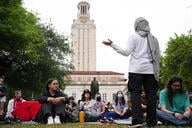You have /5 articles left.
Sign up for a free account or log in.

Many first-generation college students are resourceful, hardworking, creative and entrepreneurial.
damircudic/E+/Getty Images
Transitioning from a diverse high school in Boston to Union College in upstate New York—which enrolls about one-quarter students of color, who may also be part of the one-quarter who are first-generation students—was a culture shock for Ashley German Soto. “I did anticipate it was going to be a challenge, but I didn’t know it was going to be this white,” says German Soto, now a junior who has found pockets where she fits in the most, such as the intercultural affairs office. There, she’s been able to meet “those who look like me, first-generation Black kids. I don’t feel like I belong in classroom settings. Sometimes I’m the only Black student.”
Well before her first semester, she had connected formally, in trainings, with her cohort of Posse Scholars—recipients of full-tuition leadership scholarships, weekly faculty mentoring and other support from Union, one of the Posse Foundation’s 64 partner institutions. “I always knew I wanted to go to college, but I didn’t know how I was going to afford college,” says German Soto. She found additional scholarships to help with room and board—and the opportunity to meet other incoming first-generation students at a preorientation for that group. Now she’s got a mix of first- and continuing-generation friends.
[block:block=176]
German Soto knows that her mother, who immigrated to the U.S. at age 18, can’t relate to campus life, but she feels her mom’s pride and support. “I honestly don’t think my mom even gets what ‘first-generation’ means. I just think she’s had to figure stuff out on her own all her life, so she’s like, ‘If I can do it, you can do it.’”
While German Soto’s story is her own, several of her experiences coincide with common responses to the latest Student Voice survey, conducted in mid-June by Inside Higher Ed and College Pulse with support from Kaplan. The survey of 1,073 first-generation undergraduates from 94 colleges and universities reveals that:
- Eight in 10 feel like they belong on campus, yet one-third of students only have a sense of belonging in certain spaces.
- Fifty-five percent have at least a few friends whose parents did not graduate with a four-year degree, either; an additional one-quarter aren’t sure of their friends’ first-generation status. Three-quarters of first-generation students reveal that characteristic to professors and classmates only sometimes.
- The top two factors contributing to initial interest in their college were affordable tuition (49 percent) and generous financial aid (38 percent).
- One-quarter of students are at colleges with first-generation orientation programs; about the same percentage of respondents’ colleges hold events for these students to meet one another.
First-generation students from racially diverse high schools generally have a harder time finding their place at many colleges, compared to those from predominantly white high schools, says RaJhai Spencer, Colgate University’s assistant dean of administrative advising, who leads the First@Colgate program that supports its 10 percent of students who are first gen. At Colgate, a house for the Office of Undergraduate Studies scholars, mainly first generation, is open to students outside that program who need a place to hang out. It includes study spaces, a living room and a kitchen.
Some students whose institutions would consider them first generation don’t identify that way. One in five survey respondents only define it as being first in both their immediate and extended family to attend college, while 44 percent see it as being first in their immediate family. As an example of the latter, Linda LeMura, president of Le Moyne College in New York, did not consider herself first generation back in college since older siblings had taken that step, making her postsecondary entrance “a natural course of events.”
About one-third of survey respondents agree with the most common first-generation definition: having parents who did not complete college.
“Institutions are not clearly identifying what they mean by ‘first generation’ or it’s not trickling down to students,” says Sarah Whitley, vice president of the Center for First-Generation Student Success at NASPA: Student Affairs Administrators in Higher Education. Even the way officials define it and how the question is asked on admissions applications are often different, she adds. “This worries me, because it means some students are not identifying, and that prevents them from accessing services, attending events or being part of programs.”
Definition debate aside, few would question that first-generation student supports are prominent in higher education conversation. Yet what frustrates Jane De León Griffin, the first to fill Bentley University’s new associate provost for student success role, is how higher ed leaders at predominantly white institutions will reference first-generation populations making them better by diversifying their campuses.
“All of that is true, but it’s still ‘how are they beneficial to us?’ as opposed to ‘why are we beneficial to them?’” says Griffin, who has been asked to pay particular attention to the success of this population in her work. First-generation students are “resourceful, hardworking, have tons of experience, are typically scrappy and entrepreneurial and creative. We should be telling them to come to Bentley because this is the place where you’re going to thrive.”
The Student Voice survey offers a snapshot of what it’s like to be a first-generation college student today, how they look at their future and what supports they may need in making connections between actions now and success later.
Institutional Attraction
Colleges and universities with robust first-generation supports may tout efforts via their admissions page. On the admissions site for Wichita State University in Kansas, for example, one of four main sections about the student experience, titled “Unmatched Support for First-Gen Students,” includes a link to the F1RST-GEN Shockers website.
“We’re very up front about it,” says Bobby Gandu, assistant vice president of strategic enrollment management at the university, where last fall’s 12,700 undergraduates included 40 percent first-generation students. “Even if relatively few first-generation students are in an audience, we want to make sure those students know we celebrate first-generation students.”
Gandu will also share the first-generation webpage with high school counselors in cities from which the institution draws students, especially in a local school district with a large percentage of low-income students. One program, aimed at increasing high school graduation for local men, provides them with student IDs so they can access the university library and discounts at community businesses. During COVID shutdowns, these teens met for remote learning in a lounge at Wichita State, and Gandu heard about their reluctance to give up that experience when their schools reopened.
Asked about 12 factors that may have contributed to interest in their college, one in five Student Voice respondents affirmed that a reputation for welcoming first-generation students drew them in. But more practical factors—affordable tuition and location close to home—had a bigger impact.
“This breaks down some of the narrative we have that students will aspire to the most prestigious college. This shows more logical thinking,” says Cecilia M. Orphan, an associate professor of higher education in the University of Denver’s Morgridge College of Education, whose course content includes how public and organizational policies affect first-generation students’ experiences. “We still have the dominant entrenched idea that students go off to college and leave home. That’s not true for most Americans.”
In a February 2022 Student Voice survey of 2,001 first-generation and continuing-generation students, which explored college choice more broadly with 26 possible factors, proximity to home came out as the top nonacademic reason students had for choosing their college.
 Although fewer than one in 10 students in the current survey cited a first-generation club as a reason for interest, Whitley from NASPA says these clubs are “everywhere,” with some of them aimed more at policy and institutional change than others. And while a lot of colleges—especially among the 277 institutions that have partnered with her center to commit to serving first-generation students—have first-generation information webpages, they often aren’t easy to find. “We have a long way to go in that work,” she says.
Although fewer than one in 10 students in the current survey cited a first-generation club as a reason for interest, Whitley from NASPA says these clubs are “everywhere,” with some of them aimed more at policy and institutional change than others. And while a lot of colleges—especially among the 277 institutions that have partnered with her center to commit to serving first-generation students—have first-generation information webpages, they often aren’t easy to find. “We have a long way to go in that work,” she says.
Gaining attention of prospective first-gen families can mean flying them in. That’s one way Centre College in Kentucky attracts finalists for the Grissom Scholars Program, which offers 10 high-achieving first-generation students a full-tuition scholarship plus $5,000 in educational enrichment funds. “We pay for parents, not just students, to come to campus,” says program director Sarah Scott. In her nine years of working with first-generation students at the college (where currently about one in five students are first gen), she has found that parents have a “willingness to understand the whole college system.”
Visions of Success
In her new role at Bentley, Griffin will examine current supports for first-generation and all students so that efforts can be more synchronized and barriers minimized. With project managers, she will establish “a clear vision for what student success looks like here” and develop metrics to determine the effectiveness of student success efforts.
Student Voice responses to a question probing personal definitions of success in college cover a variety of areas—from wanting to grow knowledge in a subject they’re passionate about (52 percent) and being a well-rounded person with knowledge in a number of areas (45 percent) to leaving college with a job in their desired field (55 percent) that allows them to support themselves (55 percent). But simply graduating (73 percent) got identified most—and was the top response to the next question about the most important indicator of success.
Carleton College in Minnesota, recognized as a First-Gen Forward institution by the Center for First-Generation Student Success, once organized a panel with students who are among the 13 percent of first-generation students there. When asked if they would consider taking a year off to explore options before committing to working or postgraduate studies, “all three panelists said, ‘no way. We don’t have time to waste—we have to support our families,’” recalls Carolyn H. Livingston, vice president for student life and dean of students.
“The idea that graduating is the most important indicator of success has been a source of challenge for us,” says Claude Taylor at Monmouth University in New Jersey, who leads First to Fly: First Generation at Monmouth. “Part of what we’re trying to do is get students to get the most out of their education.”
That involves helping students “build their social and cultural capital,” adds Taylor, director for academic transition and inclusion at the Center for Student Success. “[But] the more we try to program around broadening that experience, we see little uptake in utilization. Part of it is because our first-generation students seem laser-focused on graduating.”
Advisers at Monmouth, a First-Gen Forward institution, have noticed these students centering semester planning around this question: “What do I need to check off to get closer to graduation?” Taylor would rather see a focus on “What should I or could I be involved in to get the most out of this?” He believes obligations and commitment to representing their families well “can cloud some of their perception of our efforts to support them.”
LeMura at Le Moyne is worried about the finding that students are about twice as likely to put value on simply graduating than on graduating on time. “Students are concerned about financing higher education, as all students should be. But this is not in sync with concerns regarding costs.”
Perhaps they need help building “confidence that with the right supports, they can graduate on time,” she adds. “Anything that delays them costs them significantly in the long run. Students may not be looking decades down the road, but the compounding factor of losing out on one or two years of employment have a lot of implications.”
German Soto, like most of the Student Voice respondents, would choose graduating as more of a success indicator than graduating on time. While she does feel pressure to graduate with her Posse cohort at Union, her overall goal is still just graduating, even if it takes longer.
The way Griffin sees it, “there is all this pressure to ‘finish in four,’ but students know that it often takes longer than a four-year period. It’s almost as if they are anticipating challenges and want to build in time for that.”
Orphan at the University of Denver recognizes a related policy issue. “As we continue to push on-time completion, how does that work against goals that students have for themselves?”
On the student loan front, she points to the stark difference between her own first-generation experience—where a Pell Grant combined with a state opportunity grant covered her full tuition—and today’s first-generation students. They are loan-averse but must still take out student loans because the country’s commitment to truly helping first-generation students with college aspirations “has eroded. It’s unfair they have to think so much about student loan debt.”
Establishing mentor relationships is another success factor few survey respondents recognize (although Livingston believes it may have emerged as more important had it been described as “someone to watch out for you and seek advice from”).
“We’ve been doing this thing alone all our lives, so asking for help, we don’t know how to,” says German Soto. “Sometimes it’s viewed as weak.” Yet, research shows that students, particularly first-gen students, benefit from close relationships with faculty members, Orphan notes.
First-gen students may view mentorship as daunting, says Whitley. They think, “What is a mentor? Why do I need one? Are they a counselor? Are they trying to fix me?”
The misperceptions may well extend to all students. In a September 2021 Student Voice survey of 2,003 undergrads (first- and continuing-generation), fewer than one-quarter of the 44 percent who had not had a mentor said they would really want one.
Connection Actions and Reactions
Do students in the current Student Voice survey reveal first-generation identities to professors and classmates? Respondents are most likely to do so “only in relevant discussions/situations.” One-quarter never share.
German Soto says she will always “do my best to tell people. I view it as an accomplishment.” She’ll also, however, notice assumptions from some faculty and students that first-gen students are all poor and minorities, and that “we all have a relative that has died. It’s completely insane the amount of stereotypes they’ve given us.”
When Orphan was an undergraduate about 20 years ago, “it felt like something you tried to hide and maybe didn’t even have the language for.” It wasn’t until her third year, when she transferred to a regional public university and began hearing professors identify themselves as first generation, that she began identifying herself.
One-quarter of Student Voice respondents say they’ve had one professor who shared a first-generation identity, with an additional 17 percent saying more than one professor has done so. Did it matter? Two-thirds of students say the reveal had a positive impact.
Whitley’s takeaway: “It’s worth the effort to get faculty to acknowledge their identity, or allyship, and to have resources on the syllabus.” As for those who didn’t seem to care, maybe they have already connected with others on campus and don’t feel a need to feel closer to professors.
Some institutions provide office door identifiers (e.g., Centre’s “We Are First” postcards) or create posters (used around the Wichita State campus and in student newsletters, for example) for these professors. Such efforts normalize the idea of successful academics coming from families without college experience. Plus, Gandu explains, students are more likely to reach out when faculty and staff are outspoken about their status. “It shows they’ve walked that journey before and could be a resource.”
Carleton maintains a detailed first-gen faculty directory online, including basic info and words of wisdom. “We wanted students to know who the faculty and staff were, but also wanted faculty and staff to know each other,” Livingston says. While introducing themselves at orientation sessions to students and parents, she, the provost and the dean have begun highlighting that they were first generation in college.
LeMura, who says that identity of hers comes up in conversation often, sees it as a lost opportunity when such experiences aren’t shared. “This is the stuff of life, the great inspiration that comes from those who by their actions or outcomes show that good things are possible.”
As noted, about eight in 10 current Student Voice survey respondents feel as if they belong, at least in certain spaces, on campus. But the 753 first-generation students responding to a January 2022 Student Voice survey were more likely to struggle with fitting in, with about half saying that it wasn’t an issue at all or much. Continuing-generation students in that survey (n=1,249) were about 10 percentage points more likely to say it wasn’t really an issue.
While participating in campus activities is a natural way to fit in, in the current survey only half of respondents are involved in extracurriculars. Work and family commitments may account for that, but Whitley has heard from many colleges this year that they’re “really struggling with student involvement in general.” “The pizza and free stuff doesn’t work anymore. Students aren’t joining organizations as much.”
“The pandemic has rewritten student life and involvement,” says Gandu. His department, usually a popular spot for student helpers, has struggled to fill paid tour guide positions and volunteer roles. Suddenly students are asking, “What’s in this for me?” So his department has touted the development of public speaking and other soft skills, that they can provide employee references, and how admissions ambassadors tend to be leaders elsewhere on campus, so it can be a great way to connect with other student leaders.
German Soto—whose activities include being an orientation leader, a tour guide and president of the Black Student Union—says the large number of students who aren’t involved surprises her. “I’m grateful for the fact that I’m involved in so much. It was a big thing for me to get involved, because I knew it was going to be hard for me on campus. It was my first time being away from home that long.” Initially, her commitments presented a time management issue, but “I did get better at it.”
At Monmouth, Taylor’s department has committed to building first-generation student leadership opportunities. “We’re nudging them off the sidelines,” he says. One example is an advisory council launching this fall. “First-generation students can have conversations with and make recommendations to me and others working with our initiative about what they need, what they see, what’s meaningful.” His hope is that they’ll take on leadership roles in other campus organizations, too.
Off-campus employment tends to be less flexible for students interested in campus involvement, yet those jobs might pay more. Carleton caps the number of on-campus work hours by year in college, creating issues in certain cases. Some students, particularly first-gen students, will note how they juggled high school with jobs requiring many more hours a week, or will explain that they have a responsibility to send some money earned during college home (even $40 of an $80 paycheck), Livingston says.
A good number of Colgate’s first-gen students get involved on campus plus work, many of them multiple jobs, says Spencer. She recently advised a few students struggling to keep up on course assignment deadlines to cut back on work hours—and helped them figure out what financial needs could be fixed to make that happen. “Find two to three things you’re passionate about,” she will tell students. “You don’t want to just be a member—you want to contribute.” A good mix of activities includes something related to one’s major or aspirations plus “something where you can have fun and relax.”
Persistence Assistance
Students facing academic, time management, financial or other struggles are at risk for leaving their institutions—and half of the Student Voice survey respondents have at least considered transferring or dropping out.
This past year, one Bentley student on academic probation was not improving her grades. “She was very close to being suspended for a year,” says Griffin. “My fear was that she was never going to come back. Come to find out, she was working 30 hours a week off campus to support her family.” Bentley staff are helping her find on-campus employment, which would eliminate her commute and allow her job to better accommodate her commitments as a student.
German Soto’s supports have included Andrew Alvez, the assistant director of intercultural affairs who has mentored her through Union’s Bridges Program for first-gen students, and her Posse cohort. But during her first term, she found herself thinking about transferring or leaving college altogether. “I had Dru in my ear, saying I was going to make it, that he was going to be there for me every step of the way.”
And her Posse group has committed to being there for each other if any one of them falters. “They’d be the first people to tell me not to go. They’d throw my car keys away,” she says.
Some colleges get creative about supporting students who must pause their studies. The PATH (Possibilities at the Heights) program established in 2021 at Le Moyne, for example, is for certain students needing a leave of absence to work or care for a family member. During the leave, they can maintain ties to the college by taking up to four credits of online courses for free.
In reality, some students will leave and no amount of effort will bring them back. But colleges could “facilitate ongoing communication, so that if they’re ready they can go back,” says Orphan, adding that nonprofit colleges might look to the for-profit sector for ideas.
While reasons for not continuing with college are individualized, Taylor from Monmouth says financing remains the biggest obstacle for most first-generation students—so college affordability is rightly at the center of most first-generation initiatives. In both the national conversation and at institutions, he hopes higher ed leaders keep up the momentum on supporting this population and commit to being change agents with reflection on this question: “How are we affecting change, real structural change, systemic change?”
Next week at the Student Voice news hub: more results from the first-generation students’ survey, with a focus on how they feel about the supports their institutions have to help ensure success in academics and in navigating student life.




